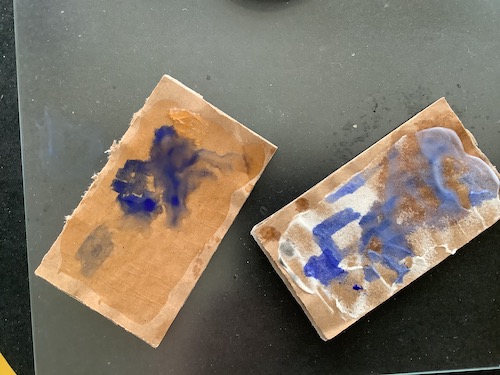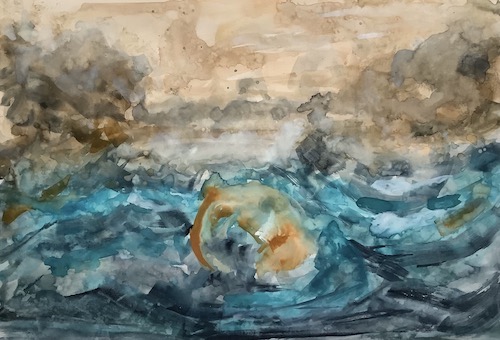Gesso's, primers and other substrates
The gesso story gets its own tail. I have set up an experiment with sand, soapstone grit, papier mache, xanthan gum, talc/baby powder, cornstarch, polenta, flour, baking soda, tartar powder, kitchen paper and toilet paper to see which material is absorbent to serve as gesso for watercolor paint.
I’ve put the various powders in heaps on a piece of paper and dripped water on top with a pipette.
The results are disappointing to say the least: either they didn’t absorb and a drop remained on the pile of powder, or they absorbed too much, making it just unworkable.
I would like to further investigate backing soda and tartaric acid as a special effect in the paint on the paintings themselves.

Later I made glue from both cornstarch and arrowroot (heat water + stuff in a pan and stir well to a firm mass) and spread it on a piece of paper. I had the most confidence in the cornstarch, because this recipe is often found on the internet. So I also smeared this on a piece of cardboard.
Unfortunately, after drying and the first coat of paint, the stuff came off in a spectacular way. It’s a shame the cornflour glue is so brittle, otherwise it could have given nice effects in mixed media.
I did a new experiment with 10 different bases on a 10×10 canvas panel. Again, it was about the absorbing effect and how well it works in watercolour. The basis for these surfaces is acrylic binder. I used the same picture and tried to work with the same colors and thickness of paint as much as possible. The outcome is a colorful collection of paintings that actually all have something. In the end, this experiment was not about absorbency, but about different effects in a watercolor that I can use later to create a specific atmosphere.

Right: All the little canvases with different kinds of substrates.
I also made a gesso using Caseine from the bottle. Casein is a protein (milk rennet) and you can use it to make tempera paint; the predecessor of oil paint. After drying it is waterproof. I also have powdered casein, but it seems that another substance has to be added to make it stable: Borax. Easily available at the drugstore, but the recipe to put it all together makes it all a bit complicated. And that while I have a bottle on my shelf that is ready to use.

I’ve mixed the casein with chalk and water and spread it on a piece of thick paper. The paintwork on it is quite blotchy, the paint definitely doesn’t flow as is usual in the magic of watercolor. Unfortunately, casein is particularly good for making paint, but not as a substrate.
I still have one ace in the hole, more about that next time.